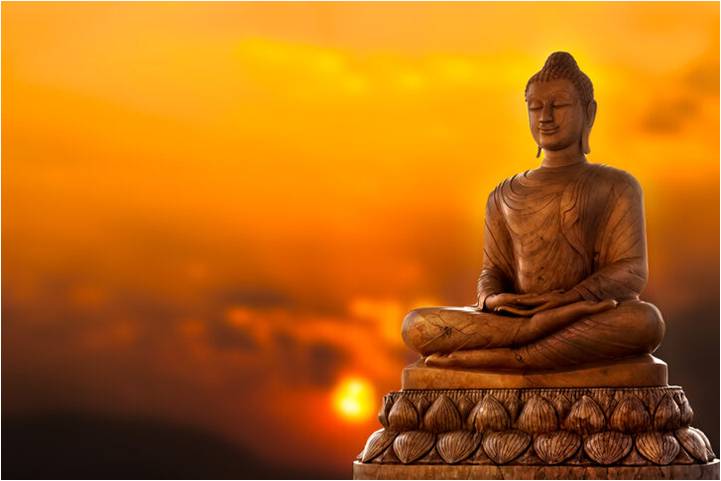
Gautam Buddha
Gautama, the Buddha also known as Siddhartha, Sakyamuni and Tathagata.
Born in 563 BC (widely accepted), on the vaisakha purnima day at Lumbini, near Kapilvastu, capital of the Sakya republic
- Father – Sudhodhan
- Mother – Mahamaya
- Wife – Yashodhara
| AGE | PLACE | EVENT | NAME | SYMBOL |
| 0 | Lumbimi, Kapilvastu | Birth | Buddha Purnima | Lotus & Bull |
| 29 | Lumbini | Great Departure | Mahabhinishkramana | Horse |
| 35 | Gaya | Enlightenment | Nirvana | Bodhi – Tree |
| 35 | Sarnath | First Sermon | Dhammachakkapravartana | Wheel |
| 80 | Kushinagar | Death | Mahaparinirvana | Stupa |
4 Noble Truths
- Dukkha- world is full of sorrows
- Samudaya, desire is the cause of sorrows
- Niroda, the cessation of dukkha –by conquering desire
- Magga, the path to conquering desire by following the 8 fold path
8 Fold Path
- The way to attain nirvana lies via the 8 fold path
- Right Understanding
- Right Thoughts
- Right Speech
- Right Action
- Right livelihood
- Right Efforts
- Right Mindfulness
- Right Concentration
Tri-Ratna of Buddhism
- Buddha (The enlightened one)
- Dhamma ( Doctrine of Buddhism)
- Sangha (Order of Buddhism)
Doctrine of Buddhism
- Buddha did not believe in soul(atman) and god or metaphysical world , concerned himself with the worldly problems
- Avoid excess of both, Luxury and Austerity , prescribed a middle path
- Laid great emphasis on Karma (Varna based on action not on birth) & Ahimsa
- Opposed varna system & laid down the principle of social equality
Literature of Buddhism
- Use of Pali – common man’s language – helped teachings spread faster
- The 3 Pitaks
- Sutta pitak – Sermons of Buddha himself
- Vinay pitak – Code of conduct for followers
- Abhidhamma Pitak – Philosophical ideas of Buddhism
Spread of Buddhism
- 2 kinds of disciples –
- Monks (Bhikshus)
- Lay worshippers (Upasakas) •
- Organized preaching – Monks organised into sangha for the purpose of spread of Buddhist teachings •
- Membership was open to all, Male or female without any class distinction •
- Less philosophical details- appealed to lower uneducated varnas •
- Kings of Magadha, Kosala and Kaushambhi embraced it. •
- Asoka adopted and spread Buddhism
Contribution of Buddhism
- Earliest Buddhist text “ Suttapitaka” pleads for protection of cattle & helped to prevent their decimation
- Taught people to put reason in everything & pleaded for logic instead of superstitions hence promoted rationalism in people
- Promoted education through residential universities like Vallabhi, Nalanda & Vikramshila
- Formed Hybrid Sanskrit by mixture of Pali & Sanskri
BUDDHIST COUNCILS
| S.No | Date | Place | Patron | Chairmanship | Major Findings |
| First | 483 BC | Rajgir | Ajatashatru | Mahakashyap | Ananda composed Suttapitaka (Buddha’s Teachings) • Upali composed Vinaypitaka ( Monastic code for Buddhism) |
| Second | 383 BC | Vaishali | KalAshoka | Sabakami | Held mainly to resolve 10 disputed points under Vinaypitaka |
| Third | 250 BC | Patliputra | Ashoka | Mogliputra Tissa | Compilation of Abhidhamma pitak took place (Philosophical exposition of Buddhism) |
| Fourth | 72 AD | Kashmir | Kanishka | Vasumitra | Resulted in division of Buddhism into Hinayana & Mahayana Asvaghosa participated in this council & all the deliberations were made in Sanskrit |
Contribution of Buddhism
Earliest Buddhist text “ Suttapitaka” pleads for protection of cattle & helped to prevent their decimation •
Taught people to put reason in everything & pleaded for logic instead of superstitions hence promoted rationalism in people •
Promoted education through residential universities like Vallabhi, Nalanda & Vikramshila •
Formed Hybrid Sanskrit by mixture of Pali & Sanskri
he doctrine of Ahimsa—so strongly stressed, devoutly preached and sincerely practiced by the Buddhists. Was incorporated in Hinduism of later days.
The practice of worshipping personal Gods, making their images and erecting temples in their honor became a part of the later day Hinduism.
Buddhism proved to be one of the greatest civilizing forces, which India gave to the neighboring countries.
Buddhism broke the isolation of India and helped in establishment of intimate contacts between India and foreign countries.
Types of Buddhism
Hinayana
(a) Its followers believed in the original teachings of Buddha,
(b) They sought individual salvation through self-discipline and meditation.
(c) They did not believe in idol-worship,
(d) Hinayana, like Jainism, is a religion without God, Karma taking the place of God.
(e) Nirvana is regarded as the extinction of all.
(f) The oldest school of Hinayana Buddhism is the Sthaviravada (Theravada in Pali) or the ‘Doctrine of the Elders’,
(f) Its Sanskrit counterpart, which is more philosophical is known as Sarvastivada or the doctrine which maintains the existence of all things, physical as well as mental,
(g) Gradually, from Sarvastivada or Vaibhasika branched oft another school called Sautantrika, which was more critical in outlook.
Mahayana:
(a) Its followers believed in the heavenliness of Buddha and sought the salvation of all through the grace and help of Buddha and Bodhisatvas.
(b) Believes in idol worship,
(c) Believes that Nirvana is not a negative cessation of misery but a positive state of bliss,
(d) Mahayana had two chief philosophical schools: the Madhyamika and the Yogachara.
(e) The former took a line midway between the uncompromising realism of Hinayanism and the idealism of Yogachara.
(f) The Yogachara school founded by Maitreyanatha completely rejected the realism of Hinayana and maintained absolute idealism.
Vajrayana:
(a) Its followers believed that salvation could be best attained by acquiring the magical power, which they called Vajra.
(b) The chief divinities of this new sect were the Taras.
(c) It became popular in Eastern India, particularly Bengal and Bihar.
Sacred Shrines of Buddhism
- Lumbini,
- Bodh-Gaya.
- Sarnath and
- Kusinagar,
where the tour principal events of the Buddha’s life, namely, Birth, Enlightenment. First sermon and Mahaparinirvana took place.
To these are added tour places
- Sravasti,
- Rajgriha.
- Vaishali and
- Sankasya—
these eight places have all along been considered as the eight holy places (ashtamahasthanas)
Other centres of Buddhism in Ancient India—
- Amravati and Nagarjunikonda in Andhra Pradesh;
- Nalanda in Bihar;
- Junagadh and Valabhi in Gujarat;
- Sanchi and Bharhut in MP;
- Ajanta-Ellora in Maharashtra,
- Dhaulagiri in Orissa;
- Kannauj. Kausambi and Mathura in UP
- Jagadala and Somapuri in West Bengal
Buddhist architecture developed essentially in three forms, viz.
(a) Stupa (relics of the Buddha or some prominent Buddhist monk are preserved)
(b) Chaitya (prayer hall)
(c) Vihara (residence)
Cause of Decline of Buddhism in India
- Revival of Brahmanism & reformation in Hinduism •
- Use of Sanskrit instead of Pali from 4th Buddhist council •
- Pushyamitra Sunga persecuted Buddhists (2nd cent BCE) •
- After birth of Mahayana, practice of Idol worship, Huge offerings & donations became common & led to the deterioration of moral standards •
- Attack of Hunas (500-600 AD) & Attack of Turkish invaders (1200 AD) destroyed major Buddhist Monasteries
How is Jainism Different From Buddhism?
- Jainism recognised the existence of god while Buddhism did not.
- Jainism does not condemn the varna system while Buddhism does.
- Jainism believed in the transmigration of soul i.e. reincarnation while Buddhism does not.
- Buddhism prescribes a middle path while Jainism advocates its followers to live the life of complete austerity.








No comment